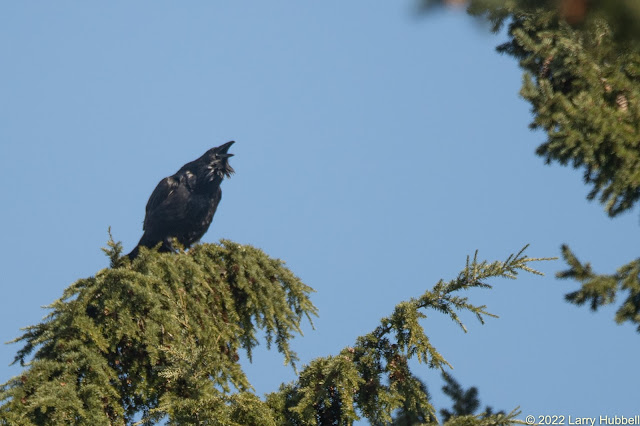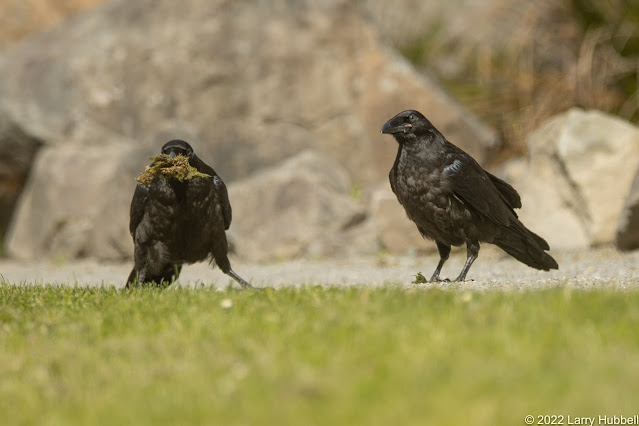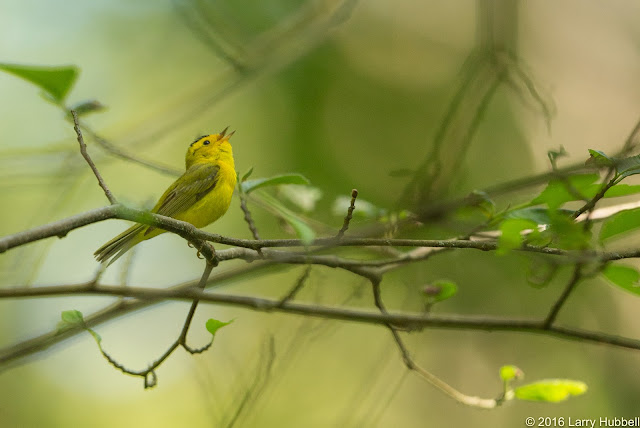I was standing alone on a seldom-used trail in the Arboretum when a flicker of motion caught my attention. When I looked up, I was surprised to see a Black-throated Gray Warbler for the first time this year.
Locally, the tiny yellow dot in front of the eye is unique to this species.
Only adult males have black throats. As I watched, it caught and ate a tiny insect.
Sometimes birdwatching can be challenging. For example, birds make no allowances for our viewing angles.
It is always wise to be quiet when watching birds, especially when looking straight up. Logic implies that lighter birds, with the same amount of muscle and energy, should fly faster than heavier birds. Noise tends to scare birds. As a result, in the moment when a startled bird spreads its wings to fly, it will often lighten its load. This is also a good time to close your mouth.
Black-throated Gray Warblers generally winter in Mexico. However, they tend to breed in British Columbia and the Western United States, particularly to the west of the Cascades in Washington state. Click Here to see an animated display of their migration process.
After the Gray Warbler moved on, I spotted a Yellow-rumped Warbler nearby. Even though we have Yellow-rumped Warblers (YRWA) here year-round, they are nonetheless migratory birds. As a matter of fact, unlike the Black-throated Grays, Yellow Rumps utilize nearly all of North America. Click Here to see their impressively widespread migration patterns. Soon thereafter I noticed this Cassin's Vireo. One of the keys to identifying this species is its white "spectacles" around the eyes along with the black mark between the eye and the bill.
Vireos tend to be heavier than warblers, have a more gray-green color, and less yellow. Their migration patterns are more similar to the Black-throated Gray Warblers than the Yellow-rumped Warblers.
Not long after this, I was forced indoors, while fighting a virus. Normally, in Spring I spend as many daylight hours as possible searching for birds and their nests around Union Bay. Being confined to the house temporarily brought my search to a stop. However, as often happens nature managed to deliver a surprise.
I began watching the trees and birds in my yard. Many years ago when we moved into our house, we were attracted in part by two mature Japanese Maple trees on the property.
The one near our front window is particularly well-suited to viewing birds. The moss-covered branches are full of tiny little lifeforms which attract Black-Capped Chickadees, Song Sparrows, Dark-eyed Juncos, and occasionally Steller's Jays.
Over the years I considered adding more species of maple trees around the property. Initially, I really did not realize the superior value of native trees over introduced species. Two of the trees I added were Red Maples which are native to the eastern portion of North America. They do attract some birds, like this Warbling Vireo which stopped by this week.
However, as I became more interested in birds I learned that native plants and trees can provide more nourishment than non-native trees. In addition, the food they provide is likely to be of the most appropriate type and at just the right time to meet the bird's needs.
This knowledge helped inspire the planting of a native Vine Maple tree in our backyard. Vine Maples are small trees that were originally found in the dappled understory in our native forests, living shaded lives below Douglas Fir, Western Hemlock, Big Leaf Maple, and Western Red Cedars.
This week when I looked out at our little Vine Maple I was surprised to spot numerous native Wilson's Warblers looking for food. In the past, I usually only found Wilson's Warblers in the Arboretum or Interlaken Park, often in the Indian Plums and not far from water.
This week, for four or five days in a row, there have been Wilson's Warblers in our yard and most often they have been in the Vine Maple.
The satisfaction of seeing them in the yard feels like an exciting reward for planting the little native tree.
Curiously, all the Wilson's Warblers I have seen lately have had black caps. According to most of my guide books, this would, theoretically, indicate they are adult males. Females are generally displayed as not having black caps.
However, in the notes from my Seattle Audubon's Master Birder Class I recorded that 20 to 30 percent of females on the Pacific Coast also have black caps. Plus, Birdweb says, "The western Washington breeding race females have dark black caps." This implies that it could be closer to 100% of the local females who have black caps.
I have occasionally seen what looked like the guidebook's description of a female Wilson's Warbler. However, they have been few and far between.
I think the safest approach with Wilson's Warblers is to simply identify the species and let the birds do the gender determination.
On the other hand, since they do breed in our area, observing mating behavior (during the next month or two) may be our only reliable chance to identify females. Birds of the World says, "Pacific lowland populations usually nest in shrubs, well-concealed by surrounding vegetation, along streams or in moist coastal woodland."
Another fun behavior to be watching for is Wilson's Warblers singing. This photo was taken in mid-May of 2016. We may start hearing their songs almost any time.
In the past, I would have assumed that the bird in this photo was male because of the black cap and because it was apparently singing to define its territory. However, it could be that neither assumption is correct.
Click Here to read about a very interesting and eye-opening study regarding the songs of female songbirds.
Click Here to see more about the migration patterns of Wilson's Warblers. Clearly the majority breed in Canada and Alaska.
In his book, "Nature's Best Hope", Professor Douglas Tallamy suggests that planting native plants and trees in our backyards may literally be nature's best chance to survive climate change and human environmental disruption. Click Here to see his video.
He suggests that specific plants and trees have an above-average positive impact on birds and nature. These exceptional types of flora, he calls keystone plants. Acers (i.e. maples) are one genus that has been identified as keystone trees. Click Here to learn more from the National Wildlife Federation that has been working with Prof. Tallamy.
Vine Maples are one of the easiest native keystone trees to add to your yard. They can grow in partial shade and they require far less room than a "full-sized" tree, like a Bigleaf Maple or a Douglas Fir. Plus, as you have seen they really do attract beautiful little birds!
Have a great day on Union Bay...where nature lives in the city!
Larry
ps: Click Here if you would like to read a post that also covers some of our other Western Washington Warblers. Recommended Citation
Ammon, E. M. and W. M. Gilbert (2020). Wilson's Warbler (Cardellina pusilla), version 1.0. In Birds of the World (P. G. Rodewald, Editor). Cornell Lab of Ornithology, Ithaca, NY, USA. https://doi.org/10.2173/bow.wlswar.01
Going Native:
Each of us, who breathe the air and drink the local water, needs to watch and protect our local environment. Native plants and trees encourage the largest diversity of lifeforms because of their long intertwined history with our local environment and native creatures. Even the microbes in the soil are native to each local landscape.
I hope we can inspire ourselves, our neighbors, and local businesses to respect native flora and to support native wildlife at every opportunity. I have learned that our most logical approach to native trees and plants (in order of priority) should be to:
1) Learn and leave established native flora undisturbed.
2) Remove invasive species and then wait to see if native plants begin to grow without assistance. (When native plants start on their own, then these plants or trees are likely the most appropriate flora for the habitat.)
3) Scatter seeds from nearby native plants in a similar habitat.
4) If you feel you must add a new plant then select a native plant while considering how the plant fits with the specific habitat and understanding the plant's logical place in the normal succession of native plants.
***************
My friend Elaine Chuang shared several resources (that were new to me) from the January 2022 Washington Ornithological Society meeting. The major new concept is that specific keystone native plants enable critical moths and caterpillars that in turn provide food for the great majority of birds, especially during the breeding season. Here are the top two links from her list.
Native Keystone Plants for Wildlife:
https://www.youtube.com/watch?v=O5cXccWx030
Resources for adding plants to your Pacific Northwest Garden:
https://wos.org/wos-wp/wp-content/uploads/2021/12/native-plant-resources-v2.pdf
***************
In the area below it is my intention to display at least one photo each week to help challenge us to know the difference between native and non-native lifeforms.
However, this week I am taking a slightly different approach. Looking at the first five photos in this post can you determine the two types of native trees depicted?
Scroll down for the answer.
******************
The two native trees are:
*****************
The Email Challenge:
Over the years, I have had many readers tell me that Google is no longer sending them email announcements. As of 2021, Google has discontinued the service.
In response, I have set up my own email list. With each post, I will manually send out an announcement. If you would like to be added to my personal email list please send me an email requesting to be added. Something like:
Larry, I want to see more of nature. Please add me to your personal email list.
Thank you for your patience and interest!
My email address is:
LDHubbell@comcast.net
*******************
The Comment Challenge:
Another common issue is losing your input while attempting to leave a comment on this blog. Often everything functions fine, however, sometimes people are unable to make it past the robot-detection challenge or maybe it is the lack of a Google account. I am uncertain about the precise issue. Sadly, a person can lose their comment with no recovery recourse.
Bottom Line:
If you write a long comment, please, copy it before hitting enter. Then, if the comment function fails to record your information, you can send the comment directly to me using email.
My email address is:
LDHubbell@comcast.net
Sincerely,
Larry
*******************
A Final Photos:














































